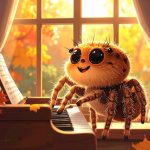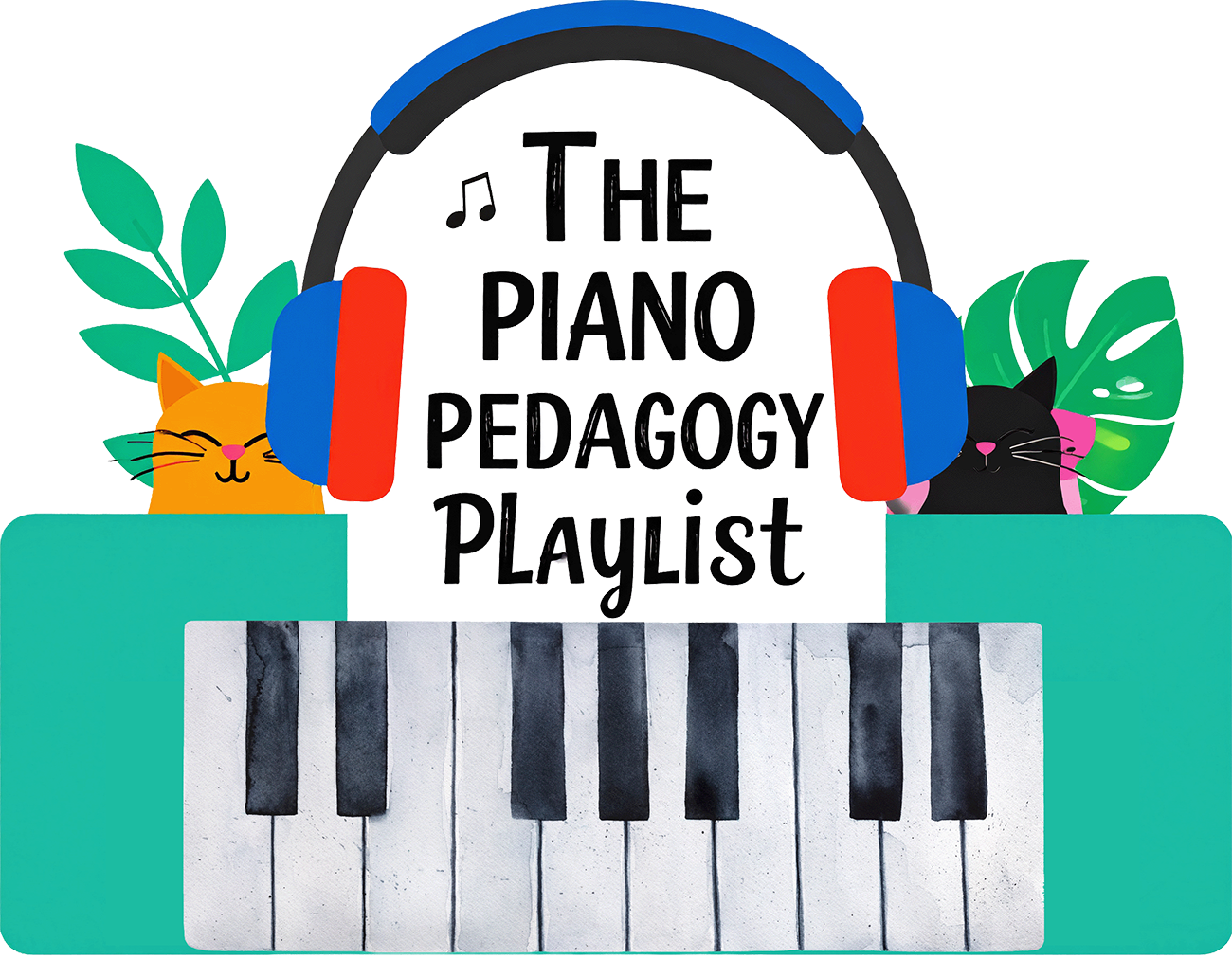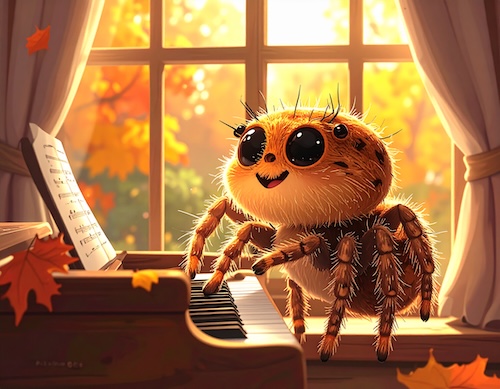
The Spider’s Masquerade, Christopher Goldston – Digital Download
Spiderweb Salsa, Jocelyn Kotchie – Digital Download
Tomb Spiders, Jocelyn Kotchie – – Digital Download
Long Legged Spinners, Stacy Fahrion – Digital Download
Spiders may make me squirm, but they sure spin some great music. In this week’s episode, I swat my fears aside to share four creepy-crawly piano pieces by Chris Goldston, Jocelyn Kotchie, and Stacy Fahrion. From tarantellas to tangly webs, these works are spooky, clever, and perfect for your students to sink their fangs into this fall.
— Transcript —
Now, if there’s one thing that my students know about me personally that doesn’t have anything to do with music, it’s that I am deathly afraid of spiders. I know they’re supposed to be good for the ecosystem, keeping the mosquito population in check, all that, but I still have a fear of them that is kind of embarrassing and irrational. But I think I’m also still suffering some of the trauma from this time when during one of my college juries, I had a live spider drop onto the piano keyboard while I was playing.Somehow, I kept it together until the first rest in the right hand was available, and I just swatted it onto the stage. So of course, with us practically on October’s doorstep, the theme for today’s podcast is spiders. Because what better way is there to face your fears than to turn them into music?
Welcome to the Piano Pedagogy Playlist. My name is Luke Bartolomeo, and I’m a piano teacher as well as the developer of the note naming app, Flashnote Derby, which by the way features horses, pegasuses, reindeer, spaceships, but as of yet, no spiders. Each Monday, I share some music that I think might be interesting and useful to all of you wonderful folks in our piano teaching community.
Music written by living composers. Anytime you come across a piece of piano music with Spider or Web in the title, it’s a safe bet that the piece is in 6-8 time. And true to form, three of today’s four pieces are indeed in 6-8 or 12-8 time.
Same difference. This is of course due to the popularity of the folk dance, the Tarantella. And this first piece I’m going to play for you is really the only one today that we could call a genuine Tarantella.
It’s named The Spider’s Masquerade. It’s written by the American composer Chris Goldston, who I actually had the good fortune of teaching alongside at the Sherwood Community Music School here in Chicago for several years. Now it has two things going for it that, at least for me, make it a little more interesting than the dozens of Tarantella pieces you’ve probably already come across in the repertoire.
The first is the introductory theme. It sets the stage with creepy, crawly, broken, augmented triads. Musically it’s very effective, and it’s also a good opportunity for a quick theory lesson on augmented chords.
Secondly, there are two spots where our traditional Tarantella rhythm is interrupted by a bit of hemiola. Our 6’8 meter suddenly feels like 3’4, just for a measure. But the way he does it here, I think it’s very effective and natural sounding.
I’m sure you’ll notice it right away when it occurs.
The Spider’s Masquerade
Did I say two spots where there was hemiola in that piece? If you counted three, then you are indeed correct. That was my performance of The Spider’s Masquerade by Christopher Goldston.
Chris has a website where he has self-published many of his own compositions, but also some of those by his mother, the late Margaret Goldston. Pieces that were either unpublished or out of print previously. Links can be found in the description.
Now, while it’s true that the Tarantella is overwhelmingly the most common dance form to be associated with spiders, we’re going to turn now to a Latin-inspired piece called Spiderweb Salsa, also a dance. In this short piece, Australian composer Jocelyn Kotchie depicts a spider dancing in a very cool and sophisticated way across his web. It couldn’t be more different than the Tarantella we just heard.
The composer’s tempo marking is with finesse. It’s a good reminder that all this playful energy in the piece has to be conveyed without letting the tempo get away from you. Keep it cool.
Spiderweb Salsa
That was Spiderweb Salsa. And though it sounds deceptively easy, it’s actually quite tricky rhythmically. It would require a student who could be very meticulous about counting out the syncopated rhythms.
To this end, it’s actually published in two different versions. There’s a version where the syncopations are written as ties, and then there’s another edition where the syncopations are just written out as single notes that sometimes start on the offbeat and then extend into the next beat. I chose the version with the ties because for me, it provides a better visual representation, I think, of where the syncopations lie.
So our first two pieces have both been fairly light-hearted treatment of our spider theme today, but things are going to turn a bit darker with our third piece. It’s also written by the same composer, Jocelyn Kotchie. This piece is called Tomb Spiders, Tomb Spiders, and it paints a much more graphic picture in my mind of these little creatures that have caused me so much anxiety over the years.
Something about this piece kind of makes my skin crawl a little bit, but I could imagine students really getting into the imagery.
Tomb Spiders
Now, in addition to perfecting the interpretation, students will have to deal with a couple of showy finger passages in that piece. Fortunately, fingerings are provided, and they are good fingerings. So if you teach this piece, make sure your student is diligent about following them from the start.
Again, that was Tomb Spiders by Aussie composer Joe Kotchie. I guess being from Australia, she would know a thing or two about spiders. Only one more piece to go in our Spiderathon, and it’s another very evocative piece.
You know how it’s possible to be repulsed or scared by something, but at the same time fascinated by it, like you can’t look away? If you’ve ever seen one of those close-up videos of a spider spinning its web, or wrapping up it’s dinner, you might know what I’m talking about. If there was a soundtrack to go with the expression on my face when watching one of those spider videos, it would be this piece, Long Legged Spinners, by the American composer, Stacy Fahrion.
It captures not only the creepiness, but also the beauty and the artistry of the spider’s craft.
Long Legged Spinners
I really dig that piece. If you also enjoyed Long Legged Spinners, you should definitely check out Stacy Fahrion’s entire book of spider-inspired pieces. It’s called Lullabies for Arachnophobes.
My favorite description that I found online calls it, An album of piano solos created to help distract you from thinking about how spiders might be crawling on you while you sleep. Thank you so much for that imagery, Internet. I’m sure I’ll sleep much better tonight.
In all seriousness, though, I did check out all ten of the pieces in Lullabies for Arachnophobes, and it is a very unique, creative, and musically interesting collection. They aren’t easy pieces, but they would be well worth exploring by the more advanced student, especially one who has an interest in what Ms. Fahrion would call the whimsically macabre. Links to this collection, as well as to all of the pieces featured today, can be found in the episode description.
Or you can go to our website, pianopedagogyplaylist.com.
And just like that, it’s time to grab an old shoe and squash the life out of this week’s episode of the Piano Pedagogy Playlist. I’ll have to scuttle off for now, but I’ll be back next Monday spinning up some more of what’s best in the repertoire of contemporary music for piano students. Keep nurturing the music, and have a great week.




Leave a Reply